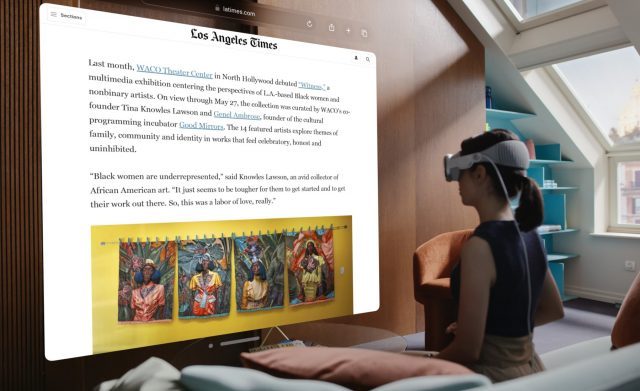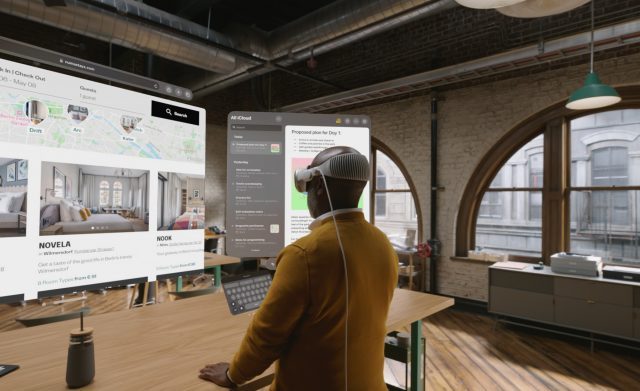Cloudhead Games is one of the most successful and senior VR studios in the industry. In this Guest Article, studio head Denny Unger shares his thoughts on Apple’s entrance into the space.
Denny Unger is CEO and CCO at Cloudhead Games. Based in British Columbia and founded in 2012 Cloudhead’s pioneering approach to VR gave rise to broadly adopted movement standards including Snap Turns and Teleportation. Working closely with Valve, Sony, and Meta, Cloudhead is best known for their title Pistol Whip and has shipped four popular VR titles (Pistol Whip, Valve’s Aperture Hand Labs, Call of the Starseed, and Heart of the Emberstone).
So let’s get the obvious over first; Apple Vision Pro is Apple’s first generation attempt at AR glasses using a Mixed Reality VR headset. AVP is a development platform also serving an enthusiast demographic. Make no mistake, this no compromise MR device appears to get many things right for AR at a premium cost. Will Cloudhead Games be buying one to better understand Apple’s approach? Heck yes. AVP will give developers a powerful foundation and ecosystem for which to develop AR apps for a future ‘glasses formfactor’ device in that mythical 5–10 year window. And to the victor, the spoils of a smartphone replacing device.
No doubt (and if rumors are true) there were many debates at Apple HQ about VR. Whether or not to open the device up to VR studios and successful titles. Whether or not to include controllers to support legacy VR titles. Whether to allow users to full-dive into Virtual Reality, freely move around, and be active in the medium. But in an effort to sharpen their messaging, and to command a dominating lead within the AR space, VR and its many benefits were expertly omitted on nearly every level. Do I understand the strategy to strike a different cord as an XR business owner? Absolutely. Does it frustrate me as a VR-centric studio owner? You bet it does.

I question why the AVP didn’t maximize its potential, leveraging almost a decade of know-how from the VR community working within this space. Why not set a vision for a future device that would accommodate both AR and VR as complimentary mediums? Apple could have embraced a dual launch strategy with a rich and proven catalog of best selling VR games, perfectly tuned to onboard a completely new audience to XR. Apple could have expanded into VR’s recent success, growth and competition within the current market. In their recent presentation VR is essentially reduced to a gimmick, the thing you lightly touch the edges of, instead of a complimentary and equally important medium. Unity engine support is promised but with no plans for motion control support, Apple has cut out any possibility of porting most of the existing or future VR catalog to its platform.
Hand-tracking is a logical affordance for AR based spatial computing and no doubt some experiences will work well with that design philosophy. However it is important to point out that most VR games built over the last 10 years (and many more in production) are not compatible with, nor will they ever be “portable” to hand-tracking only design. Inputs and Haptics are incredibly important to Virtual Reality as a major tenant in reinforcing immersion and tactile interaction with virtual objects. Buttons pushed, triggers pulled, vibrational feedback experienced, objects held, thrown or touched, alternative movement schemes supported. There is a comfort in understanding the topological landscape of a controller and a physical touchpoint within the virtual environments themselves. When introducing users to a radically different medium like VR, convention & feedback matters. And over the last 50 years in gaming, input has evolved to encourage a suite of highly refined game design standards, creating a particular kind of muscle memory in the gaming population. Say what you will about which genres remain popular in this 450 Billion dollar industry but it does strain belief to think we’ll all be playing with finger guns in the latest and greatest shooter.
I know what some are likely to say “ there will be new innovative standards and we’ll look back on controllers as a crutch”, but I would push back and say hand-tracked or not, moving away from future haptic devices and innovation is a backwards step in XR design. Even smartphone games utilize basic haptics, because touch is foundational to the human experience.
In the aftermath of the AVP launch some would argue that VR is not yet mainstream and that Apple did the right thing by ignoring it. I would argue that VR turned a significant mainstream corner when Quest 2 outsold Xbox, when Sony reentered the market with PSVR2, and when Google teamed up with Samsung to work on what’s next, and on it goes. Over its 10 year rebirth, the last 3 years of VR have experienced Hockey Stick levels of growth. OEM’s have increased investments, and significant indicators keep coming with more titles earning revenues north of $20 Million. Fully immersive VR is a legitimized medium not because I say it is but because people like it, and are willing to part with their hard earned money to experience it.

I hope Apple is more inclusive of VR over time but the Apple Vision Pro appears to be a VR headset pretending not to be a VR headset. Because of this strategy it represents a unique opportunity for Apple’s competitors to double-down on supporting Virtual Reality at a more affordable entry point. Sure, they can all wage the 5-10 year war for a smartphone replacement but why in the world would one ignore an equally compelling revenue stream within a blended MR ecosystem? Maybe, because it took too long to go mainstream? Sorry all, we had to learn a few things along the way but I’m happy to say that after 10 years, the trail ahead has never been this clear.
Article From & Read More ( Cloudhead Games CEO: Apple Vision Pro is an AR Headset Wearing VR Clothes - Road to VR )https://ift.tt/PvYa2co
Technology


No comments:
Post a Comment